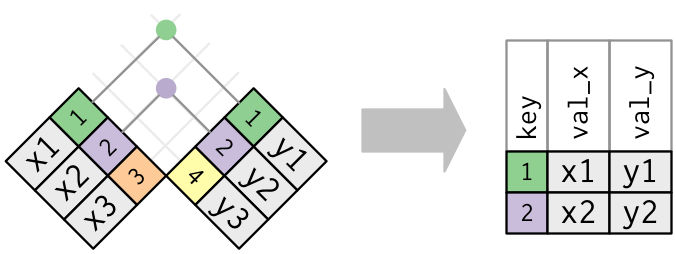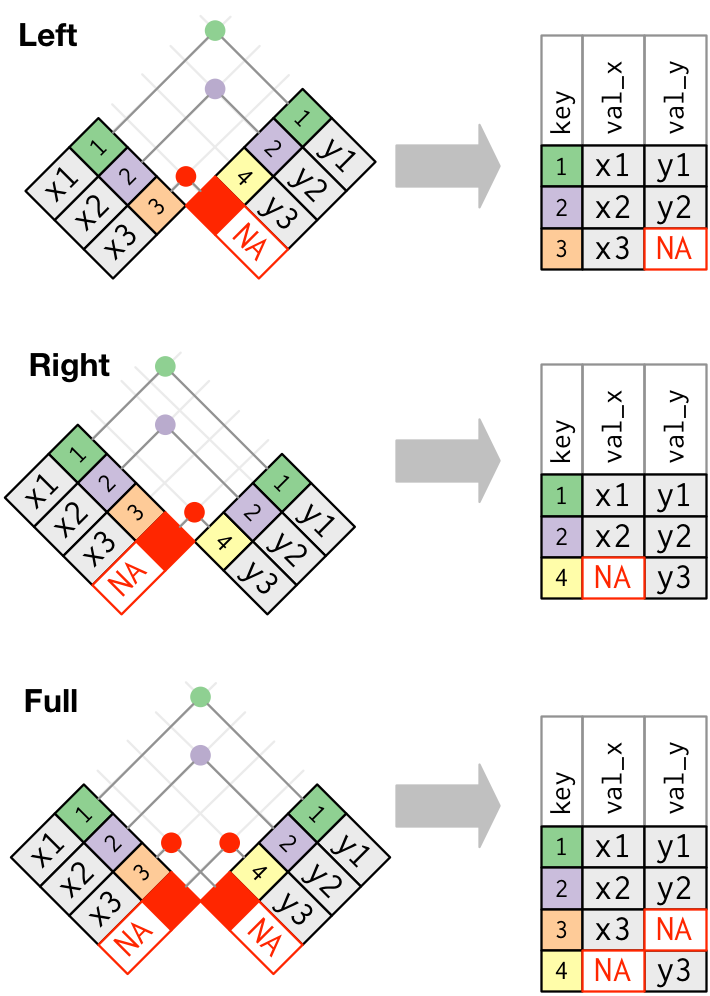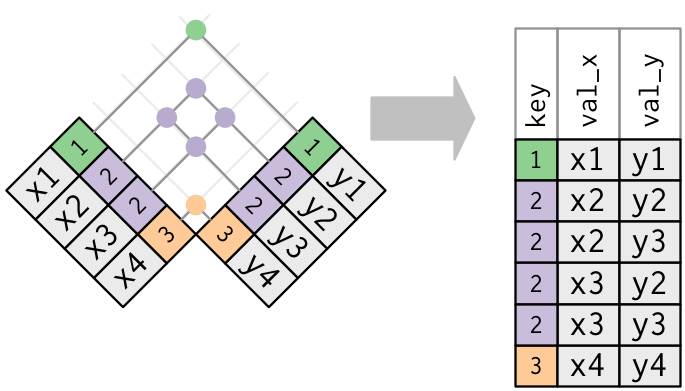Joining tables
Overview
Teaching: XX min
Exercises: XX minQuestions
Join tables in R
Objectives
Understand the need and concept of table joins
Understand the different types of joins
Understand the importance of keys in joins and the implications of using non-unique keys
Joining tables
In many real life situations, data are spread across multiple tables. Usually this occurs because different types of information about a subject, e.g. a patient, are collected from different sources.
It may be desirable for some analyses to combine data from two or more tables into a single data frame based on a column that would be common to all the tables, for example, an attribute that uniquely identifies the subjects.
The dplyr package provides a set of join functions for combining
two data frames based on matches within specified columns.
For further reading, please refer to the chapter about table joins in R for Data Science.
The Data Transformation Cheat Sheet also provides a short overview on table joins.
Combining tables
We are going to illustrate join using a common example from the bioinformatics world, where annotations about genes are scattered in different tables that have one or more shared columns.
The data we are going to use are available in the following package.
if (!require("rWSBIM1207"))
BiocManager::install("UCLouvain-CBIO/rWSBIM1207")
library("rWSBIM1207")
data(jdf)
The data is composed of several tables.
The first table, jdf1, contains protein UniProt1 unique
accession number (uniprot variable), the most likely sub-cellular
localisation of these respective proteins (organelle variable) as
well as the proteins identifier (entry).
jdf1
# A tibble: 25 × 3
uniprot organelle entry
<chr> <chr> <chr>
1 P26039 Actin cytoskeleton TLN1_MOUSE
2 Q99PL5 Endoplasmic reticulum/Golgi apparatus RRBP1_MOUSE
3 Q6PB66 Mitochondrion LPPRC_MOUSE
4 P11276 Extracellular matrix FINC_MOUSE
5 Q6PR54 Nucleus - Chromatin RIF1_MOUSE
6 Q05793 Extracellular matrix PGBM_MOUSE
7 P19096 Cytosol FAS_MOUSE
8 Q9JKF1 Plasma membrane IQGA1_MOUSE
9 Q9QZQ1-2 Plasma membrane AFAD_MOUSE
10 Q6NS46 Nucleus - Non-chromatin RRP5_MOUSE
# … with 15 more rows
The second table, jdf2, contains the name of the gene that codes for the
protein (gene_name variable), a description of the gene
(description variable), the uniprot accession number (this is the
common variable that can be used to join tables) and the species the
protein information comes from (organism variable).
jdf2
# A tibble: 25 × 4
gene_name description uniprot organism
<chr> <chr> <chr> <chr>
1 Iqgap1 Ras GTPase-activating-like protein IQGAP1 Q9JKF1 Mmus
2 Hspa5 78 kDa glucose-regulated protein P20029 Mmus
3 Pdcd11 Protein RRP5 homolog Q6NS46 Mmus
4 Tfrc Transferrin receptor protein 1 Q62351 Mmus
5 Hspd1 60 kDa heat shock protein, mitochondrial P63038 Mmus
6 Tln1 Talin-1 P26039 Mmus
7 Smc1a Structural maintenance of chromosomes protein 1A Q9CU62 Mmus
8 Lamc1 Laminin subunit gamma-1 P02468 Mmus
9 Hsp90b1 Endoplasmin P08113 Mmus
10 Mia3 Melanoma inhibitory activity protein 3 Q8BI84 Mmus
# … with 15 more rows
We now want to join these two tables into a single one containing all variables.
We are going to use the full_join function of dplyr to do
so,
Th function will automatically find the common variable (in this case uniprot)
to match observations from the first and second table.
library("dplyr")
Attaching package: 'dplyr'
The following objects are masked from 'package:stats':
filter, lag
The following objects are masked from 'package:base':
intersect, setdiff, setequal, union
full_join(jdf1, jdf2)
Joining, by = "uniprot"
# A tibble: 25 × 6
uniprot organelle entry gene_name description organism
<chr> <chr> <chr> <chr> <chr> <chr>
1 P26039 Actin cytoskeleton TLN1… Tln1 Talin-1 Mmus
2 Q99PL5 Endoplasmic reticulum/Golgi ap… RRBP… Rrbp1 Ribosome-b… Mmus
3 Q6PB66 Mitochondrion LPPR… Lrpprc Leucine-ri… Mmus
4 P11276 Extracellular matrix FINC… Fn1 Fibronectin Mmus
5 Q6PR54 Nucleus - Chromatin RIF1… Rif1 Telomere-a… Mmus
6 Q05793 Extracellular matrix PGBM… Hspg2 Basement m… Mmus
7 P19096 Cytosol FAS_… Fasn Fatty acid… Mmus
8 Q9JKF1 Plasma membrane IQGA… Iqgap1 Ras GTPase… Mmus
9 Q9QZQ1-2 Plasma membrane AFAD… Mllt4 Isoform 1 … Mmus
10 Q6NS46 Nucleus - Non-chromatin RRP5… Pdcd11 Protein RR… Mmus
# … with 15 more rows
In these examples, each observation of the jdf1 and jdf2
tables are uniquely identified by their UniProt accession number. Such
variables are called keys. Keys are used to match observations
across different tables.
Now let’s look at a third table, jdf3. It also contains the column uniProt,
but it is written differently!
jdf3
# A tibble: 25 × 4
gene_name description UniProt organism
<chr> <chr> <chr> <chr>
1 Iqgap1 Ras GTPase-activating-like protein IQGAP1 Q9JKF1 Mmus
2 Hspa5 78 kDa glucose-regulated protein P20029 Mmus
3 Pdcd11 Protein RRP5 homolog Q6NS46 Mmus
4 Tfrc Transferrin receptor protein 1 Q62351 Mmus
5 Hspd1 60 kDa heat shock protein, mitochondrial P63038 Mmus
6 Tln1 Talin-1 P26039 Mmus
7 Smc1a Structural maintenance of chromosomes protein 1A Q9CU62 Mmus
8 Lamc1 Laminin subunit gamma-1 P02468 Mmus
9 Hsp90b1 Endoplasmin P08113 Mmus
10 Mia3 Melanoma inhibitory activity protein 3 Q8BI84 Mmus
# … with 15 more rows
In case none of the variable names match, we can set manually the variables to
use for the matching. These variables can be set using the by argument,
as shown below with the jdf1 (as
above) and jdf3 tables, where the UniProt accession number is
encoded using a different capitalisation.
names(jdf3)
[1] "gene_name" "description" "UniProt" "organism"
full_join(jdf1, jdf3, by = c("uniprot" = "UniProt"))
# A tibble: 25 × 6
uniprot organelle entry gene_name description organism
<chr> <chr> <chr> <chr> <chr> <chr>
1 P26039 Actin cytoskeleton TLN1… Tln1 Talin-1 Mmus
2 Q99PL5 Endoplasmic reticulum/Golgi ap… RRBP… Rrbp1 Ribosome-b… Mmus
3 Q6PB66 Mitochondrion LPPR… Lrpprc Leucine-ri… Mmus
4 P11276 Extracellular matrix FINC… Fn1 Fibronectin Mmus
5 Q6PR54 Nucleus - Chromatin RIF1… Rif1 Telomere-a… Mmus
6 Q05793 Extracellular matrix PGBM… Hspg2 Basement m… Mmus
7 P19096 Cytosol FAS_… Fasn Fatty acid… Mmus
8 Q9JKF1 Plasma membrane IQGA… Iqgap1 Ras GTPase… Mmus
9 Q9QZQ1-2 Plasma membrane AFAD… Mllt4 Isoform 1 … Mmus
10 Q6NS46 Nucleus - Non-chromatin RRP5… Pdcd11 Protein RR… Mmus
# … with 15 more rows
As can be seen above, the variable name of the first table is retained in the joined one.
Challenge
Using the
full_joinfunction, join tablesjdf4andjdf5. What has happened for observationsP26039andP02468?Solution
full_join(jdf4, jdf5)Joining, by = "uniprot"# A tibble: 14 × 6 uniprot organelle entry gene_name description organism <chr> <chr> <chr> <chr> <chr> <chr> 1 P26039 Actin cytoskeleton TLN1… <NA> <NA> <NA> 2 Q99PL5 Endoplasmic reticulum/Golgi ap… RRBP… <NA> <NA> <NA> 3 Q6PB66 Mitochondrion LPPR… <NA> <NA> <NA> 4 P11276 Extracellular matrix FINC… <NA> <NA> <NA> 5 Q6PR54 Nucleus - Chromatin RIF1… <NA> <NA> <NA> 6 Q05793 Extracellular matrix PGBM… <NA> <NA> <NA> 7 P19096 Cytosol FAS_… Fasn Fatty acid… Mmus 8 Q9JKF1 Plasma membrane IQGA… <NA> <NA> <NA> 9 Q9QZQ1-2 Plasma membrane AFAD… <NA> <NA> <NA> 10 Q6NS46 Nucleus - Non-chromatin RRP5… <NA> <NA> <NA> 11 P02468 <NA> <NA> Lamc1 Laminin su… Mmus 12 P08113 <NA> <NA> Hsp90b1 Endoplasmin Mmus 13 Q8BI84 <NA> <NA> Mia3 Melanoma i… Mmus 14 Q6P5D8 <NA> <NA> Smchd1 Structural… Mmus
P26039andP02468are only present injdf4andjdf5respectively, and their respective values for the variables of the table have been encoded as missing.
Different types of joins
Above, we have used the full_join function, that fully joins two
tables and keeps all observations, adding missing values if
necessary. Sometimes, we want to be selective, and keep observations
that are present in only one or both tables.
- An inner join keeps observations that are present in both tables.

- A left join keeps observations that are present in the left (first) table, dropping those that are only present in the other.
- A right join keeps observations that are present in the right (second) table, dropping those that are only present in the other.
- A full join keeps all observations.

Challenge
Join tables
jdf4andjdf5, keeping only observations injdf4.Solution
left_join(jdf4, jdf5)Joining, by = "uniprot"# A tibble: 10 × 6 uniprot organelle entry gene_name description organism <chr> <chr> <chr> <chr> <chr> <chr> 1 P26039 Actin cytoskeleton TLN1… <NA> <NA> <NA> 2 Q99PL5 Endoplasmic reticulum/Golgi ap… RRBP… <NA> <NA> <NA> 3 Q6PB66 Mitochondrion LPPR… <NA> <NA> <NA> 4 P11276 Extracellular matrix FINC… <NA> <NA> <NA> 5 Q6PR54 Nucleus - Chromatin RIF1… <NA> <NA> <NA> 6 Q05793 Extracellular matrix PGBM… <NA> <NA> <NA> 7 P19096 Cytosol FAS_… Fasn Fatty acid… Mmus 8 Q9JKF1 Plasma membrane IQGA… <NA> <NA> <NA> 9 Q9QZQ1-2 Plasma membrane AFAD… <NA> <NA> <NA> 10 Q6NS46 Nucleus - Non-chromatin RRP5… <NA> <NA> <NA>
Challenge
Join tables
jdf4andjdf5, keeping only observations injdf5.Solution
right_join(jdf4, jdf5)Joining, by = "uniprot"# A tibble: 5 × 6 uniprot organelle entry gene_name description organism <chr> <chr> <chr> <chr> <chr> <chr> 1 P19096 Cytosol FAS_MOUSE Fasn Fatty acid synthase Mmus 2 P02468 <NA> <NA> Lamc1 Laminin subunit gamma-1 Mmus 3 P08113 <NA> <NA> Hsp90b1 Endoplasmin Mmus 4 Q8BI84 <NA> <NA> Mia3 Melanoma inhibitory activity p… Mmus 5 Q6P5D8 <NA> <NA> Smchd1 Structural maintenance of chro… Mmus
Challenge
Join tables
jdf4andjdf5, keeping observations observed in both tables.Solution
inner_join(jdf4, jdf5)Joining, by = "uniprot"# A tibble: 1 × 6 uniprot organelle entry gene_name description organism <chr> <chr> <chr> <chr> <chr> <chr> 1 P19096 Cytosol FAS_MOUSE Fasn Fatty acid synthase Mmus
Multiple matches
Sometimes, keys aren’t unique.
In the jdf6 table below, we see that the accession number Q99PL5 is repeated
twice. According to this table, the ribosomial protein binding protein 1 localises in the
endoplasmic reticulum and in the Golgi apparatus.
jdf6
# A tibble: 5 × 4
uniprot organelle entry isoform
<chr> <chr> <chr> <dbl>
1 P26039 Actin cytoskeleton TLN1_MOUSE 1
2 Q99PL5 Endoplasmic reticulum RRBP1_MOUSE 1
3 Q99PL5 Golgi apparatus RRBP1_MOUSE 2
4 Q6PB66 Mitochondrion LPPRC_MOUSE 1
5 P11276 Extracellular matrix FINC_MOUSE 1
If we now want to join jdf6 and jdf2, the variables of the latter
will be duplicated.
inner_join(jdf6, jdf2)
Joining, by = "uniprot"
# A tibble: 5 × 7
uniprot organelle entry isoform gene_name description organism
<chr> <chr> <chr> <dbl> <chr> <chr> <chr>
1 P26039 Actin cytoskeleton TLN1_MOU… 1 Tln1 Talin-1 Mmus
2 Q99PL5 Endoplasmic reticulum RRBP1_MO… 1 Rrbp1 Ribosome-b… Mmus
3 Q99PL5 Golgi apparatus RRBP1_MO… 2 Rrbp1 Ribosome-b… Mmus
4 Q6PB66 Mitochondrion LPPRC_MO… 1 Lrpprc Leucine-ri… Mmus
5 P11276 Extracellular matrix FINC_MOU… 1 Fn1 Fibronectin Mmus
In the case above, repeating is useful, as it completes jdf6 with
correct information from jdf2.
But one needs however to be careful when duplicated keys exist in both tables.
Let’s now use jdf7 for the join. It also has 2 entries for the uniprot Q99PL5
jdf7
# A tibble: 5 × 6
gene_name description uniprot organism isoform_num measure
<chr> <chr> <chr> <chr> <dbl> <dbl>
1 Rrbp1 Ribosome-binding protein 1 Q99PL5 Mmus 1 102
2 Rrbp1 Ribosome-binding protein 1 Q99PL5 Mmus 2 3
3 Iqgap1 Ras GTPase-activating-like pro… Q9JKF1 Mmus 1 13
4 Hspa5 78 kDa glucose-regulated prote… P20029 Mmus 1 54
5 Pdcd11 Protein RRP5 homolog Q6NS46 Mmus 1 28
Let’s we create an inner join between jdf6 and jdf7 (both having duplicated Q99PL5 entries)
inner_join(jdf6, jdf7)
Joining, by = "uniprot"
# A tibble: 4 × 9
uniprot organelle entry isoform gene_name description organism isoform_num
<chr> <chr> <chr> <dbl> <chr> <chr> <chr> <dbl>
1 Q99PL5 Endoplasmic … RRBP… 1 Rrbp1 Ribosome-b… Mmus 1
2 Q99PL5 Endoplasmic … RRBP… 1 Rrbp1 Ribosome-b… Mmus 2
3 Q99PL5 Golgi appara… RRBP… 2 Rrbp1 Ribosome-b… Mmus 1
4 Q99PL5 Golgi appara… RRBP… 2 Rrbp1 Ribosome-b… Mmus 2
# … with 1 more variable: measure <dbl>
Challenge
Interpret the result of the inner join above, where both tables have duplicated keys.
Solution
jdf6has two entries, one for each possible sub-cellular localisation of the protein.jdf7has also two entries, referring to two different quantitative measurements (variablemeasure). When joining the duplicated keys, you get all possible combinations.
In this case, we obtain wrong information: both proteins in the ER and in the GA both have value 102 and 3.
inner_join(jdf6, jdf7)Joining, by = "uniprot"# A tibble: 4 × 9 uniprot organelle entry isoform gene_name description organism isoform_num <chr> <chr> <chr> <dbl> <chr> <chr> <chr> <dbl> 1 Q99PL5 Endoplasmic … RRBP… 1 Rrbp1 Ribosome-b… Mmus 1 2 Q99PL5 Endoplasmic … RRBP… 1 Rrbp1 Ribosome-b… Mmus 2 3 Q99PL5 Golgi appara… RRBP… 2 Rrbp1 Ribosome-b… Mmus 1 4 Q99PL5 Golgi appara… RRBP… 2 Rrbp1 Ribosome-b… Mmus 2 # … with 1 more variable: measure <dbl>
Matching across multiple keys
So far, we have matched tables using a single key (possibly with different names in the two tables). Sometimes, it is necessary to match tables using multiple keys. A typical example is when multiple variables are needed to discriminate different rows in a tables.
Following up from the last example, we see that the duplicated UniProt
accession numbers in the jdf6 and jdf7 tables refer to different
isoforms of the same RRBP1 gene.
jdf6
# A tibble: 5 × 4
uniprot organelle entry isoform
<chr> <chr> <chr> <dbl>
1 P26039 Actin cytoskeleton TLN1_MOUSE 1
2 Q99PL5 Endoplasmic reticulum RRBP1_MOUSE 1
3 Q99PL5 Golgi apparatus RRBP1_MOUSE 2
4 Q6PB66 Mitochondrion LPPRC_MOUSE 1
5 P11276 Extracellular matrix FINC_MOUSE 1
jdf7
# A tibble: 5 × 6
gene_name description uniprot organism isoform_num measure
<chr> <chr> <chr> <chr> <dbl> <dbl>
1 Rrbp1 Ribosome-binding protein 1 Q99PL5 Mmus 1 102
2 Rrbp1 Ribosome-binding protein 1 Q99PL5 Mmus 2 3
3 Iqgap1 Ras GTPase-activating-like pro… Q9JKF1 Mmus 1 13
4 Hspa5 78 kDa glucose-regulated prote… P20029 Mmus 1 54
5 Pdcd11 Protein RRP5 homolog Q6NS46 Mmus 1 28
To uniquely identify isoforms, we should consider two keys:
-
the UniProt accession number (named
uniprotin both tables) -
and the isoform number (called
isoformandisoform_numrespectively)
Because the isoform status was encoded using different names
(which is, of course a source of confusion), jdf6 and jdf7 are
only automatically joined based on the shared uniprot key.
If the isoform status was encoded the same way in both tables, the join would have been automatically done on both keys!
Here, we need to join using both keys and need to explicitly name the variables used for the join.
inner_join(jdf6, jdf7, by = c("uniprot" = "uniprot", "isoform" = "isoform_num"))
# A tibble: 2 × 8
uniprot organelle entry isoform gene_name description organism measure
<chr> <chr> <chr> <dbl> <chr> <chr> <chr> <dbl>
1 Q99PL5 Endoplasmic reti… RRBP… 1 Rrbp1 Ribosome-b… Mmus 102
2 Q99PL5 Golgi apparatus RRBP… 2 Rrbp1 Ribosome-b… Mmus 3
We now see that isoform 1 localised to the ER and has a measured value of 102, while isoform 2, that localised to the GA, has a measured value of 3.
Ideally, the isoform variables should be named identically in the two tables to enable an automatic join with the two keys.
An alternative could be to rename the isoform_num from jdf7 in order to
have the both keys names present in both tables, enabling an automatic join.
This can be done easily using the rename function from dplyr package.
jdf7 %>% rename(isoform = isoform_num)
# A tibble: 5 × 6
gene_name description uniprot organism isoform measure
<chr> <chr> <chr> <chr> <dbl> <dbl>
1 Rrbp1 Ribosome-binding protein 1 Q99PL5 Mmus 1 102
2 Rrbp1 Ribosome-binding protein 1 Q99PL5 Mmus 2 3
3 Iqgap1 Ras GTPase-activating-like protein… Q9JKF1 Mmus 1 13
4 Hspa5 78 kDa glucose-regulated protein P20029 Mmus 1 54
5 Pdcd11 Protein RRP5 homolog Q6NS46 Mmus 1 28
inner_join(jdf6,
jdf7 %>%
rename(isoform = isoform_num))
Joining, by = c("uniprot", "isoform")
# A tibble: 2 × 8
uniprot organelle entry isoform gene_name description organism measure
<chr> <chr> <chr> <dbl> <chr> <chr> <chr> <dbl>
1 Q99PL5 Endoplasmic reti… RRBP… 1 Rrbp1 Ribosome-b… Mmus 102
2 Q99PL5 Golgi apparatus RRBP… 2 Rrbp1 Ribosome-b… Mmus 3
Row and column binding
There are two other important functions in R, rbind and cbind,
that can be used to combine two dataframes.
cbindcan be used to bind two data frames by columns, but both must have the same number of rows.
d2
a b
1 4 4
2 5 5
d3
v1 v2 v3
1 1 3 5
2 2 4 6
cbind(d2, d3)
a b v1 v2 v3
1 4 4 1 3 5
2 5 5 2 4 6
rbind, can be used to bind two data frames by rows, but both must have the same number of columns, and the same column names!
d1
x y
1 1 1
2 2 2
3 3 3
d2
a b
1 4 4
2 5 5
using rbind(d1, d2) would produce an error because both data frames do not have the
same column names (even if they have the same number of columns)
If we change the names of d2, it works!
names(d2) <- names(d1)
d1
x y
1 1 1
2 2 2
3 3 3
d2
x y
1 4 4
2 5 5
rbind(d1, d2)
x y
1 1 1
2 2 2
3 3 3
4 4 4
5 5 5
Note that beyond the dimensions and column names that are required to
match, the real meaning of rbind is to bind data frames that contain
observations for the same set of variables - there is more than only
the column names!
Note: rbind and cbind are base R functions. The tidyverse
alternatives from the dplyr package are bind_rows and bind_cols
and work similarly.
-
UniProt is the protein information database. Its mission is to provide the scientific community with a comprehensive, high-quality and freely accessible resource of protein sequence and functional information. ↩
Key Points
Join tables of data in R
